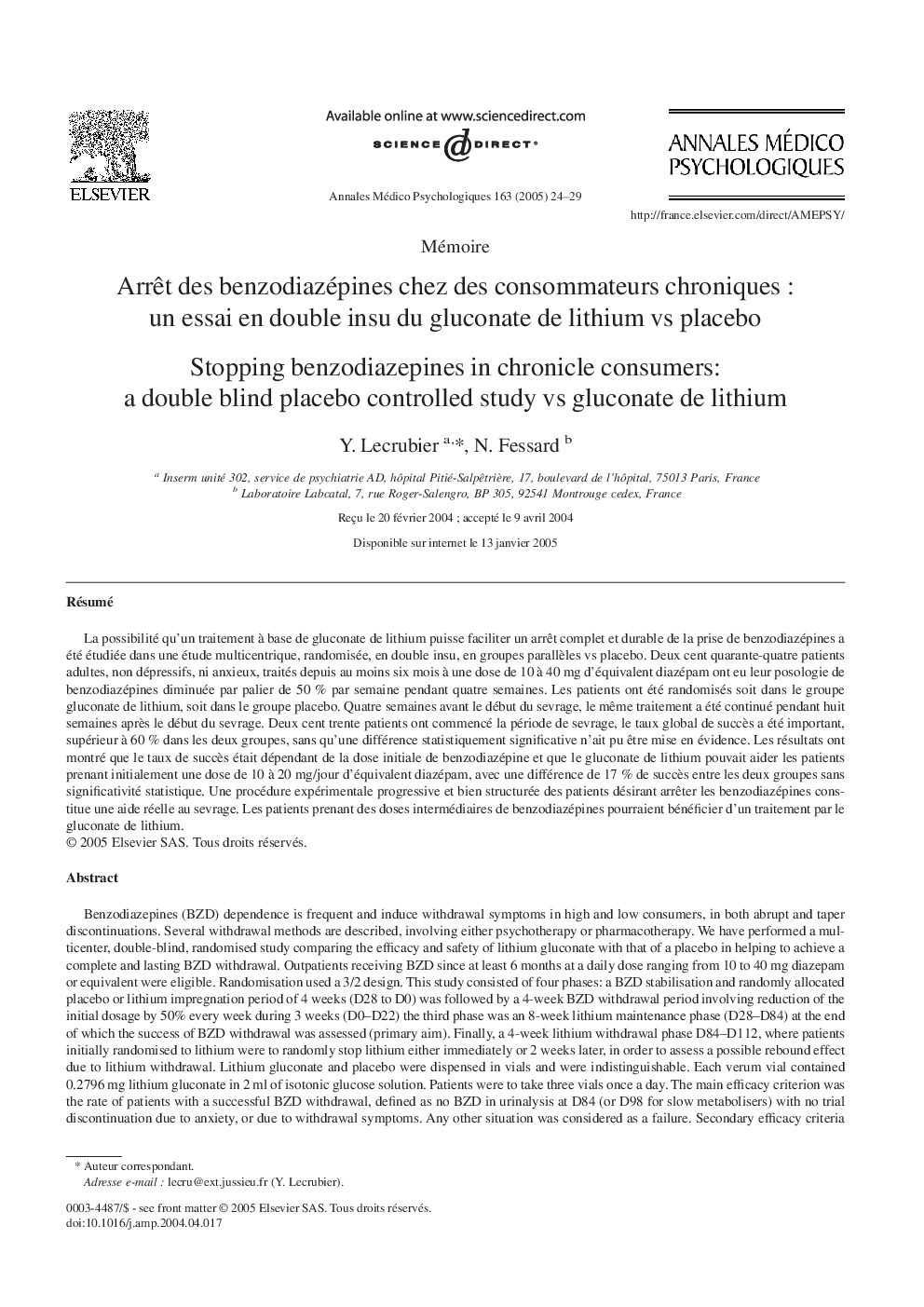| کد مقاله | کد نشریه | سال انتشار | مقاله انگلیسی | نسخه تمام متن |
|---|---|---|---|---|
| 10297337 | 536772 | 2005 | 6 صفحه PDF | دانلود رایگان |
عنوان انگلیسی مقاله ISI
Arrêt des benzodiazépines chez des consommateurs chroniques : un essai en double insu du gluconate de lithium vs placebo
دانلود مقاله + سفارش ترجمه
دانلود مقاله ISI انگلیسی
رایگان برای ایرانیان
کلمات کلیدی
موضوعات مرتبط
علوم پزشکی و سلامت
پزشکی و دندانپزشکی
روانپزشکی و بهداشت روانی
پیش نمایش صفحه اول مقاله

چکیده انگلیسی
Benzodiazepines (BZD) dependence is frequent and induce withdrawal symptoms in high and low consumers, in both abrupt and taper discontinuations. Several withdrawal methods are described, involving either psychotherapy or pharmacotherapy. We have performed a multicenter, double-blind, randomised study comparing the efficacy and safety of lithium gluconate with that of a placebo in helping to achieve a complete and lasting BZD withdrawal. Outpatients receiving BZD since at least 6Â months at a daily dose ranging from 10Â to 40Â mg diazepam or equivalent were eligible. Randomisation used a 3/2Â design. This study consisted of four phases: a BZD stabilisation and randomly allocated placebo or lithium impregnation period of 4Â weeks (D28 to D0) was followed by a 4-week BZD withdrawal period involving reduction of the initial dosage by 50% every week during 3Â weeks (D0-D22) the third phase was an 8-week lithium maintenance phase (D28-D84) at the end of which the success of BZD withdrawal was assessed (primary aim). Finally, a 4-week lithium withdrawal phase D84-D112, where patients initially randomised to lithium were to randomly stop lithium either immediately or 2Â weeks later, in order to assess a possible rebound effect due to lithium withdrawal. Lithium gluconate and placebo were dispensed in vials and were indistinguishable. Each verum vial contained 0.2796 mg lithium gluconate in 2Â ml of isotonic glucose solution. Patients were to take three vials once a day. The main efficacy criterion was the rate of patients with a successful BZD withdrawal, defined as no BZD in urinalysis at D84 (or D98 for slow metabolisers) with no trial discontinuation due to anxiety, or due to withdrawal symptoms. Any other situation was considered as a failure. Secondary efficacy criteria included overall evaluation of treatment effect by both the investigator and the patient, and changes over time of COVI, HAMA and Physician's Withdrawal Checklist (PWC) mean scores. Efficacy parameters were compared between verum and placebo overall and according to the initial dosage of BZD. Safety was assessed on all patients who took at least one dose of the study treatment. Success rates in BZD withdrawal were analysed using the Fisher's exact test for the overall comparison and using the Cochran-Mantel-Haenszel (CMH) test for the comparison by initial BZD dosage. Changes over time in scores were analysed using non-parametric Wilcoxon-Mann-Whitney U tests for treatment effect comparison. Of 244Â patients who entered the study, 146Â were randomised to lithium gluconate and 98Â to placebo. Eighty-six patients did not complete the study: 14Â patients discontinued before the BZD withdrawal phase; 72Â patients discontinued between BZD withdrawal and the end of the trial. The main reason for discontinuation was the recurrence of anxiety for 44Â patients (22Â in each group). Drop-out rates did not differ among treatment groups. All premature discontinuations were considered as failure. A total of 230Â patients entered the BZD withdrawal phase and were taken into account for the ITT analyses, 136Â patients allocated to lithium and 94Â to placebo, of whom 32Â presented a major protocol violation. Finally 198Â patients were valid for the per-protocol analyses, 118Â patients in the lithium group and 80Â in the placebo one. There were no significant differences in demography and baseline characteristics among the two treatment groups. The overall success rates were high, over 60%, without significant difference between the two treatment groups. When considering the initial BZD daily dose, for patients taking 10Â mg or less BZD, the success rates were still very high in both treatment groups without significant difference between them. There was too few patients doses over 20Â mg/day to allow a relevant comparison. Nevertheless, for patients taking medium dosage, 11-20Â mg/day, a difference of average 17.2% was observed between the two treatment groups in favour of the verum, without reaching statistical significance due to the size of this sub-group (lithium 61, placebo 38). The changes over time in anxiety scales (COVI, HAMA) and in withdrawal scales (Tyrer, PWC) did not allow to show any treatment effect, as expected with the observed low baseline scores. No effect of lithium withdrawal was reported. There was no rebound effect observed. The investigators assessed the safety of the products as 'good' or 'very good' for 95.7% of the patients allocated to lithium and 96.7% of those allocated to placebo. The success rates observed in the placebo group were unexpectedly high, over 60%, probably because of the intensive monitoring of the patients, leading to a difference between the two groups less important than expected and to an important lack of power of the trial. The main conclusion that can be drawn from this trial is the importance of a psychological help provided by the general practitioner. Nevertheless, the data suggested a positive effect of lithium gluconate in the BZD withdrawal, especially when taking into account the BZD initial dose: patients wishing to withdraw BZD and treated with BZD medium dosages seem to have better response when taking lithium in addition to the intensive monitoring, whereas in those treated with small BZD dosage are probably able to withdraw their treatment without drug therapy. There was not enough patients with high BZD initial dosage to draw any conclusion.
ناشر
Database: Elsevier - ScienceDirect (ساینس دایرکت)
Journal: Annales Médico-psychologiques, revue psychiatrique - Volume 163, Issue 1, February 2005, Pages 24-29
Journal: Annales Médico-psychologiques, revue psychiatrique - Volume 163, Issue 1, February 2005, Pages 24-29
نویسندگان
Y. Lecrubier, N. Fessard,